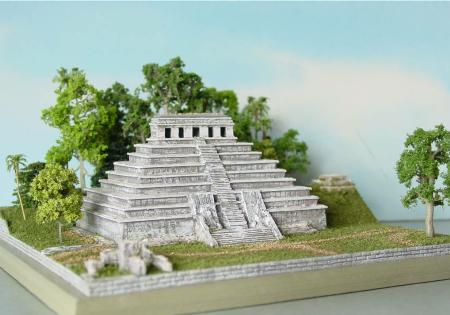
TEMPLE OF INSCRIPTIONS . Palenque, Mexico . 5.5" x 5.5" x 3"tall

TEMPLE OF INSCRIPTIONS . Palenque, Mexico . 5.5" x 5.5" x 3"tall
|
Palenque is considered to be the most beautifully conceived of the Mayan city-states, and one of the loveliest archaeological sites in the world. Scattered throughout the area, piercing the dark green jungles, are great pyramids, towers and temple complexes. The ruin's existence was unknown until 1773. And even then, they were rediscovered and lost several times until 1841. Scattered pottery shards show that the site was occupied from as early as 300 BC, but most of the buildings were constructed between the 7th and 10th centuries AD. Then mysteriously the great city was abandoned and finally, reclaimed by the jungle. Only 34 structures have been excavated of an estimated 500 that are scattered around the area. Originally these structures were coated with white plaster and painted in a rainbow of pastel hues. As one looks around the site, small hills are visible everywhere. These are not hills however, but Mayan structures long overgrown with the intense jungle. On the southern edge of the central plaza of Palenque, set against a steep limestone hill, the Temple of the Inscriptions is one of the most impressive buildings at the site. During excavation of the room at the top, the Mexican Archeologist Alberto Ruz Lhuillier discovered a hidden chamber and a concealed stairway filled with rubble. It took 4 years to follow the verticle stairs into the pyramid below the temple floor. The steps terminate in a chamber which contained the crypt of Pacal - the most imprtant ruler at the site. Pascal's remains, adorned with jade ornaments and his face covered with a jade mask, were deposited in a stone sarcophagus covered with an elaborately carved stone. It was Pacal himself who had this magnificent pyramid built and his son/heir Chan Bahlum who completed it. The temple is visible from miles away. It consists of eight stepped terraces , each banded with a molding that lends a horizontal line to the structure. A narrow stairway leads up to the temple. The front of the temple is composed of five doorways separated by 5 piers. Chan Bahlum used these surfaces for stucco illustrations or inscriptions supporting his divine legacy. The Temple of the Inscriptions is aligned with the Sun. At winter solstice, the sun sets behind the high ridge beyond the temple, in line with the center of the temple roof. As the sun crosses the sky, it enters a doorway in the temple, hits the back wall and, as it heads for the horizon beyond the temple, appears to descent the temple stairway directly into Pacal's tomb. |
| CLOSE THIS PAGE |